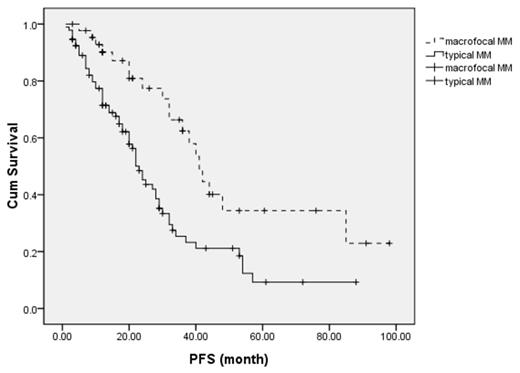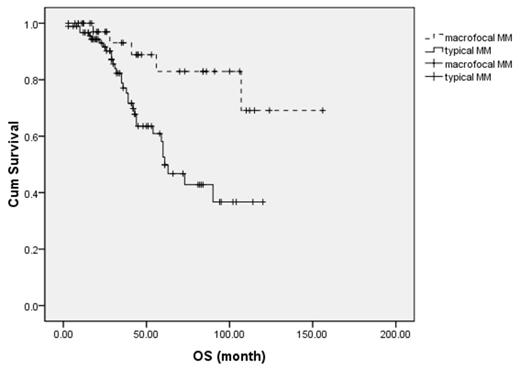Abstract
Some young multiple myeloma (MM) patients, coined macrofocal MM, have been reported to present with multiple lytic bone lesions and less than 10% bone marrow plasma cells (BMPCs). They usually have low tumor burden and favorable outcome. To further understand the clinical and laboratory features of macrofocal MM, we retrospectively analyzed about 1000 symptomatic MM patients of two centers and found that 49 (4.9%) patients fulfilled the criteria of macrofocal MM. Median age was 54 years; 39 (80%) were male. The immunoglobulin subtype included IgG (13), IgA (5), IgD (4), light chain only (4) and non-secretory type (23). International Staging System (ISS) stage 1 in 45 (92%), and no stage 3 patient. Durie-Salmon (DS) Staging System stage 3A in 48 (98%), and 2A in 1. Extramedullary plasmacytomas (EMPs) in 39 (80%) patients. The mean percentage of BMPCs was 2.1%, and 44 (90%) patients had less than 5% BMPCs. No patients had hypercalcemia and renal impairment. FISH cytogenetics, available in 11 patients, showed IgH translocation in 7, 13q del in 2, t(4;14) in 1, 1q21 amp in 6 and p53 del in 2 patients. Serum free light chain (sFLC), available in 14 patients, showed abnormal sFLC in 7 of 14 patients and 4 in 7 non-secretory type patients. Thirty eight (77.6%) patients received new drug-based induction therapies and 14 patients received autologous stem cell transplantation (ASCT) as consolidation therapy. After a median follow-up of 36 months,the estimated median progression-free survival (PFS) was 41 months and the median overall survival time (OS) had not been reached. Forty four macrofocal MM with ISS stage 1 and DS stage 3A were compared to all (93) typical symptomatic MM patients who were diagnosed at the same period with the same stages according to both ISS and DS Staging System. For macrofocal MM, there were significantly more male patients and EMPs, higher hemoglobin levels and lowerb2-microglobulin (b2M) levels than that of typical MM. There were no significant differences in the proportions of patients received novel agents-based chemotherapy and ASCT between two groups, however, the estimated median PFS of macrofocal MM was significant superior to typical MM (41 vs 23 months, respectively; P= 0.001) (Figure 1), and the estimated median OS was also better in macrofocal MM than typical MM (not reached vs 61 months; P= 0.004) (Figure 2). Multivariate analysis showed that only the type of disease was the independent prognostic factor of both PFS and OS. In summary, Macrofocal MM is a particular subgroup of MM with multiple bone lesions and lower tumor burden, higher frequency of EMPs, and better survival than typical symptomatic MM.
Fan:The National Natural Science Foundation of China: Research Funding. Hou:Novartis: Membership on an entity's Board of Directors or advisory committees.
Author notes
Asterisk with author names denotes non-ASH members.



